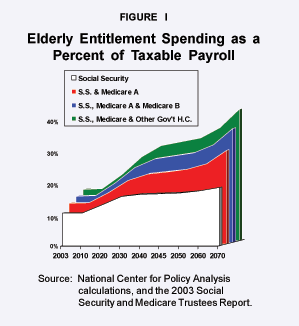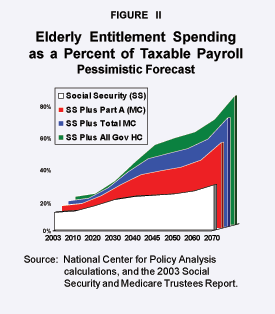The 2003 annual reports for Social Security and Medicare highlight the financial burdens these programs will create for future generations. If they are not reformed in a timely and responsible way, Social Security and Medicare will consume an ever-increasing portion of workers' incomes as the government seeks to keep its promises to future retirees.
Rising Payroll Tax Rates: Intermediate Projections.
Social Security and Medicare Part A (Hospital Insurance) payments are funded by a 15.3 percent payroll tax on wages. However, since these two programs together consume only 13.4 percent of taxable payroll, they run a small surplus each year. This will not last. According to the Trustees' "intermediate" forecast [see Figure I]:
When today's college students reach retirement age in 2050, their children and grandchildren will face a payroll tax rate of 17.3 percent just to pay Social Security benefits – a 40 percent increase over today's burden.
When Medicare Part A is included, the payroll tax burden will have to rise to 24.4 percent – almost a fourth of all the wages workers will earn that year.
To grasp the full burden of elderly entitlements on future taxpayers, we must also consider benefits paid through Medicare Part B (Supplemental Medical Insurance) and other government programs, including Medicaid and the Veterans Health Administration. Although these costs are paid from general revenues, they too can be expressed as a percentage of taxable payroll:
If the government's share of Medicare Part B is added to Social Security and Medicare Part A, the burden on workers will climb to 29.2 percent by 2050.
When such other elderly health care expenses as Medicaid and veterans' benefits are added, the total burden will reach 33.6 percent by midcentury.
Thus, more than one of every three dollars future workers earn has already been committed to pay benefits promised under current law. That's one-third off the top, before any bridges or highways are built and before any teachers' or police officers' salaries are paid. If any new entitlement benefits such as prescription drugs or long-term care benefits are added, the future burden will be even higher.
Rising Payroll Tax Rates: Pessimistic Projections.
Nor is this the worst that can happen. The estimates in Figure I are based on the intermediate projections of the Social Security Trustees. Under the Trustees' pessimistic projection, by 2050 the total amount needed to support elderly benefits will climb to 56.6 percent of taxable payroll, more than half the incomes of future workers. [see Figure II.]
The intermediate assumptions are touted as "most likely" to happen. However, the pessimistic assumptions may be more accurate predictors of future health care expenditures. The intermediate projections reflect recent experience. In recent years, year-to-year inflation in medical costs has been moderate compared to the annual inflation increases of a few years ago. Many believe the recent lower inflation rate is due to temporary factors and that health care costs will soar.
Rising Income Tax Rates.
If the payroll tax rate is not raised to cover the increasing costs of Social Security and Medicare, the federal government will have to dip into general income tax revenues. Right now, Social Security and Medicare add to the funds available for other federal spending because the payroll taxes collected more than cover the full cost of today's Social Security and Medicare benefits. However:
By 2030, about the midpoint of the baby boomer retirement years, the two programs will need about 36.5 percent of all federal income taxes to pay full benefits.
By 2050, Social Security and Medicare will require more than half of federal income tax revenue – 54.2 percent – in addition to the payroll taxes they will receive.
Again, these figures are based on the intermediate projections, so the reality could be worse.
Social Security and Medicare Are Pay-As-You-Go.
Elderly entitlement programs are in trouble precisely because they are based on pay-as-you-go financing. Every dollar collected in payroll taxes is spent the very moment it comes in the door. Nothing is saved. Nothing is invested. The payroll taxes contributed by today's workers pay the benefits of today's retirees. Likewise, when today's workers retire, their benefits will be paid only if the next generation of workers agrees to pay even higher taxes.
What About the Trust Funds?
Unfortunately, the Social Security and Medicare Trust Funds serve no real economic function. They exist purely for accounting purposes – to keep track of surpluses and deficits in the inflow and outflow of money. The accumulated Social Security surplus consists of paper certificates (nonnegotiable bonds) kept in filing cabinets in Social Security offices in West Virginia. These bonds cannot be sold on Wall Street or to foreign investors. They can only be returned to the Treasury. In essence, they are little more than IOUs the government writes to itself.
Every payroll tax check written by employers is written to the U.S. Treasury. Every Social Security benefit check comes from the U.S. Treasury. The trust funds neither receive money nor disburse it. Moreover, every asset of the trust funds is a liability of the Treasury. Summing over both agencies of government (the trust funds plus the Treasury), the balance is zero. For the Treasury to write a Social Security check, the government must first tax or borrow.
Solutions.
President Bush and others have proposed personal retirement accounts as a solution to Social Security's financial problem. The Bush plan would allow younger workers to set aside some of their Social Security money in personal accounts, which would be invested in the market. The accounts would earn market returns over the workers' lives and pay part of their Social Security benefits at retirement. Since each generation would save toward its own retirement, the burden of Social Security on future generations would be dramatically reduced.
Matt Moore is a policy analyst with the National Center for Policy Analysis.